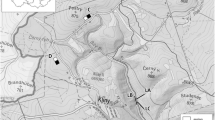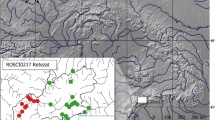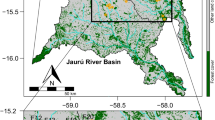Abstract
Island biogeography theory, and the 50/500 rule of genetics, have effectively devalued small habitat fragments for species conservation. Metapopulation theory has given new value to small remnants but data on species persistence are scarce. This study examined the capacity of very small and sheep-grazed remnants of eucalypt woodland in agricultural Western Australia to support remnant-dependent terrestrial arthropods. We surveyed 53 sheep-grazed remnants of wheatbelt wandoo Eucalyptus capillosa for the presence of four species of arthropod with different dispersal strategies (terrestrial versus aerial) and diet (predaceous vs. herbivorous): the harvester and mound-building termite Drepanotermes tamminensis, the wood-eating and mound-building termite Amitermes obeuntis, the predaceous and burrowing scorpion Urodacus armatus and the predaceous 'bull' ant Myrmecia nigriceps. All species with the exception of the scorpion disperse aerially, and all construct above-ground structures that are easily recognized. Remnants ranged in size from 50 m2 to 21 000 m2 (mean 1791 m2), in spatial isolation (distance to the nearest vegetation remnant) from 10 m to 500 m (mean 123 m) and in a length-to-width ratio (shape) from circular (mean ratio 1.0) to linear (mean ratio 4.0). Observations in small and grazed remnants were compared with observations made in six wandoo woodland sites within a large (1040 ha) and ungrazed remnant. The total number of target species was highly correlated with remnant area (r = 0.68). Remnant isolation and remnant shape had no apparent influence on the total number of target species. The minimum area of grazed remnants in which individual species were recorded followed the large predator Urodacus armatus (4515 m2) > smaller predator Myrmecia nigriceps (300 m2) > harvester termites Drepanotermes tamminensis (102 m2) > wood-eating termites Amitermes obeuntis (50 m2). With the exception of U. armatus which occurred only in three of the four largest grazed remnants, the occurrence of all other species increased from small to large grazed remnants, suggesting a remnant-size effect for all species. Remnant isolation or remnant shape had no apparent influence on the occurrence of any one species. The terrestrially dispersing scorpion persisted in remnants despite their isolation from other remnants from 200 m to 500 m. For both termite species, mound heights were significantly greater in large, ungrazed woodlands than in small and grazed woodlands. The incidence of mound abandonment in smaller and grazed remnants was considerably higher for harvester than for wood-eating termite colonies. This suggests differences in spatial requirements and possibly diet-related susceptibilities to fluctuations in food availability. The diameter of Myrmecia nigriceps nests showed no relationship with remnant size or isolation. This study demonstrated that even very small remnant woodlands on farms may play an important role in sustaining small native animals, either as stepping-stones for dispersing individuals (termites, ants) or in providing adequate habitat to sustain populations for longer periods (all four species).
Similar content being viewed by others
References
Abensperg-Traun M (1992) The effects of sheep-grazing on the subterranean termite fauna (Isoptera) of the Western Australian wheatbelt. Australian Journal of Ecology 17: 425–432
Abensperg-Traun M and De Boer ES (1990) Species abundance and habitat differences in biomass of subterranean termites (Isoptera) in the wheatbelt of Western Australia. Australian Journal of Ecology 15: 219–226
Abensperg-Traun M and Perry DH (1998) Mound-builders in the Western Australian termite fauna (Isoptera): a review of their distribution and mound characteristics. Journal of the Royal Society of Western Australia 81: 191–200
Abensperg-Traun M, Atkins L, Hobbs R and Steven DE (1998) Exotic plant invasion and understorey species richness: a comparison of two types of eucalypt woodland in agricultural western Australia. Pacific Conservation Biology 4: 21–32
Abensperg-Traun M, Smith GT, Arnold GW and Steven DE (1996a) The effects of habitat fragmentation and livestock-grazing on animal communities in remnants of gimlet Eucalyptus salubris woodland in the Western Australian wheatbelt. I. Arthropods. Journal of Applied Ecology 33: 1281–1301
Abensperg-Traun M, Steven DE and Atkins L (1996b) The influence of plant diversity on the resilience of harvester termites to fire. Pacific Conservation Biology 2: 279–285
Abensperg-Traun M, Smith GT, Steven DE and Atkins L (in press) Different woodland types, different grazing effects? Plants and soil and litter arthropods in remnant woodlands in the Western Australian wheatbelt. In: Hobbs RJ and Yates CY (eds) Temperate Eucalypt Woodlands in Australia: Biology, Conservation, Management and Restoration. Surrey Beatty and Sons, Chipping Norton, Sydney
Andersen AN (1991) The Ants of Southern Australia. A Guide to the Bassian Fauna. CSIRO, Melbourne
Angelstam P and Arnold GW (1993) Contrasting roles of remnants in old and newly impacted landscapes: lessons for ecosystem reconstruction. In: Saunders DA, Hobbs RJ and Ehrlich PR (eds) Nature Conservation 3: Reconstruction of Fragmented Ecosystems, pp 109–125. Surrey Beatty and Sons, Chipping Norton, Sydney
Arnold GW and Weeldenburg JR (1991) The Distributions and Characteristics of Remnant Native Vegetation in Parts of the Kellerberrin, Tammin, Trayning and Wyalkatchem Shires of Western Australia.Technical Memorandum No. 33. CSIRO. Division of Wildlife and Ecology, Perth
Banerjee B (1975) Growth of mounds and foraging territories in Odontotermes redemanni (Wasman)( Isoptera: Termitidae). Insectes Sociaux 22: 207–212
Cale P and Hobbs RJ (1991) Condition of road-side vegetation in relation to nutrient status. In: Saunders DA and Hobbs RJ (eds) Nature Conservation 2: The Role of Corridors, pp 353–362. Surrey Beatty and Sons, Chipping Norton, Sydney
Deligne J, Quennedy A and Blum MS (1981) The enemies and defense mechanisms of termites. In: Hermann HR (ed) Social Insects, vol. 2, pp 1–76. Academic Press, New York
den Boer PJ (1990) The survival value of dispersal in terrestrial arthropods. Biological Conservation 54: 175–192
De Souza OF and Brown VK (1994) Effects of habitat fragmentation on Amazonian termite communities.Journal of Tropical Ecology 10: 197–206
Fortin F and Arnold GW (1997) The influence of road verges on the use of nearby small shrubland remnants by birds in the central wheatbelt of Western Australia. Wildlife Research 24: 679–689
Franklin IR (1980) Evolutionary change in small populations. In: Soule ME and Wilcox BA (eds) Conservation Biology, an Evolutionary-Ecological Perspective, pp 135–149. Sinauer Associates, Sunderland, Massachusetts
Gay FJ and Calaby JH (1970) Termites of the Australian region. In: Krishna K and Weesner FM (eds) Biology of Termites, pp 393–448. Academic Press, New York
Greaves T (1962) Studies of foraging galleries and the invasion of living trees by Coptotermes acinaciformis and C. brunneus (Isoptera). Australian Journal of Zoology 10: 630–651
Greenslade PJM (1979) A Guide to Ants of South Australia. South Australian Museum, Adelaide
Greenslade P (1992) Conserving invertebrate diversity in agricultural, forestry and natural ecosystems in Australia. Agriculture, Ecosystems and Environment 40: 297–312
Hanski I and Simberloff D (1997) The metapopulation approach, its history, conceptual domain, and application to conservation. In: Hanski IA and Gilpin ME (eds) Metapopulation Biology: Ecology, Genetics, and Evolution, pp 5–26. Academic Press, New York
Haverty MI, Nutting WL and LaFage JP (1975) Density of colonies and spatial distribution of foraging territories of the desert subterranean termite, Heterotermes aureus (Snyder). Environmental Entomology 4: 105–109
Hobbs RJ and Atkins L (1988) Effects of disturbance and nutrient addition on native and introduced annuals in plant communities in the Western Australian wheatbelt. Australian Journal of Ecology 13: 171–179
Hobbs RJ and Hopkins AJM (1990) From frontier to fragments: European impact on Australia's vegetation.Proceedings of the Ecological Society of Australia 16: 93–114
Holldobler B and Wilson EO (1990) The Ants. Springer-Verlag, Berlin
Lande R (1993) Risks of population extinction from demographic and environmental stochasticity and random catastrophes. American Naturalist 142: 911–927
Landsberg J, Morse J and Khanna P (1990) Tree dieback and insect dynamics in remnants of native woodlands on farms. Proceedings of the Ecological Society of Australia 16: 149–165
Lefroy EC, Hobbs RJ and Scheltema M (1993) Reconciling agriculture and nature conservation: toward a restoration strategy for the Western Australian wheatbelt. In: Saunders DA, Hobbs RJ and Ehrlich PR (eds) Nature Conservation 3: Reconstruction of Fragmented Ecosystems, pp 243–257. Surrey Beatty and Sons, Chipping Norton, Sydney
Lobry de Bruyn LA (1993) Defining soil macrofauna composition and activity for biopedological studies: a case study on two soils in the Western Australian wheatbelt. Austuralian Journal of Soil Research 31: 83–95
MacArthur RH and Wilson EO (1967) The Theory of Island Biogeography. Princeton University Press, Princeton
Main AR (1987a) Evolution and radiation of the terrestrial fauna. In: Walton DW (ed) Fauna of Australia, vol. 1A. General Articles, pp 136–155. Australian Government Publishing Service, Canberra
Main AR (1987b) Management of remnants of native vegetation - a review of the problems and the development of an approach with reference to the wheatbelt of Western Australia. In: Saunders DA, Arnold GW, Burbidge AA and Hopkins AJM (eds) Nature Conservation: The Role of Remnants of Native Vegetation, pp 1–13. Surrey Beatty and Sons, Chipping Norton, Sydney
Majer JD, Recher H and Keals N (in press) Canopy arthropods in fragmented agricultural landscapes.In: Hobbs RJ and Yates CJ (eds) Temperate Eucalypt Woodlands in Australia: Biology, Conservation, Management and Restoration. Surrey Beatty and Sons, Chipping Norton, Sydney
McArthur WM (1991) Reference Soils of South-Western Australia. Western Australian Department of Agriculture, Perth
McArthur WM (1993) History of landscape development. In: Hobbs RJ and Saunders DA (eds) Reintegrating Fragmented Landscapes: Towards Sustainable Production and Nature Conservation, pp 10–22.Surrey Beatty and Sons, Chipping Norton, Sydney
Naeem S, Thompson LJ, Lawler SP, Lawton JH and Woodfin RM (1995) Empirical evidence that declining species diversity may alter the performance of terrestrial ecosystems. Philosophical Transactions Royal Society of London B 347: 249–262
Nel JJC (1968) Aggressive behaviour of the harvester termites Hodotermes mossambicus (Hagen) and Trinervitermes trinervoides (Sjostedt). Insectes Sociaux 15: 145–156
Neve G, Mousson L and Baguette M (1987) Adult dispersal and genetic structure of butterfly populations in a fragmented landscape. Acta Oecologica 17: 621–626
New TR (1987) Insect conservation in Australia: towards rational ecological principles. In: Majer JD (ed) The Role of Invertebrates in Conservation and Biological Survey, pp 5–20. Western Australian Department of Conservation and Land Management, Perth
Norton DA, Hobbs RJ and Atkins L (1995) Fragmentation, disturbance, and plant distribution: mistletoes in woodland remnants in the Western Australian wheatbelt. Conservation Biolology 9: 426–438
Nutting WL (1969) Flight and colony foundation. In: Krishna K and Weesner FM (eds) Biology of Termites, pp 233–282. Academic Press, New York
Park HC, Majer JD, Hobbs RJ and Bae TU (1993) Harvesting rate of the termite Drepanotermes tamminensis (Hill) within native woodland and shrubland of the Western Australian wheatbelt. Ecological Research 8: 269–275
Park HC, Majer JD and Hobbs RJ (1994) Influence of vegetation and soil types on the wheatbelt termite, Drepanotermes tamminensis (Hill), in the Western Australian wheatbelt. Ecological Research 9: 151–158
Perry DH, Watson JAL, Bunn SE and Black R (1985) Guide to the termites (Isoptera) from the extreme south-west of Western Australia. Journal of the Royal Society of Western Australia 67: 66–78
Polis GA and Winemiller KO (eds) (1996) Food Webs: Integration of Patterns and Dynamics. Chapman and Hall, New York
Sarre S, Smith GT and Meyers JA (1995) Persistence and metapopulation structure of two species of gecko (Oedura reticulata and Gehyra variagata) in remnant habitat. Biological Conservation 71: 25–33
Saunders DA, Hobbs RJ and Margules CR (1991) Biological consequences of ecosystem fragmentation: a review. Conservation Biology 5: 18–32
Saunders DA, Hobbs RJ and Arnold GW (1993) The Kellerberrin project on fragmented landscapes: a review of current information. Biological Conservation 64: 185–192
Scougall A, Majer JD and Hobbs RJ (1993) Edge effects in grazed and ungrazed Western Australian wheatbelt remnants issn relation to ecosystem reconstruction. In: Saunders DA, Hobbs RJ and Ehrlich PR (eds) Nature Conservation 3: Reconstruction of Fragmented Ecosystems, Global and Regional Perspectives, pp 163–178. Surrey Beatty and Sons, Chipping Norton, Sydney
Simberloff D (1988) The contribution of population and community biology to conservation science.Annual Review of Ecology and Systematics 19: 473–511
Simberloff D (1997) Biogeographic approaches and the new conservation biology. In: Pickett STA, Ostfeld RS, Shachak M and Likens GE (eds) The Ecological Basis of Conservation, pp 275- 284. Chapman and Hall, New York
Smith GT (1995) Species richness, habitat and conservation of scorpions in the Western Australian wheatbelt. Records of the Western Australian Museum 52: 55–66
Smith GT (1998) Density of the burrowing scorpion Urodacus armatus in relation to vegetation types: implications for population decline following agricultural clearing. Pacific Conservation Biology 4: 209–214
Smith GT, Arnold GW, Sarre S, Abensperg-Traun Mand Steven DE (1996) The effects of habitat fragmentation and livestock-grazing on animal communities in remnants of gimlet Eucalyptus salubris woodland in the Western Australian wheatbelt. II. Lizards. Journal of Applied Ecology 33: 1302–1310
Wallace KJ and Moore SA (1987) Management of remnant bushland for nature conservation in agricultural areas of southwestern Australia - operational and planning perspectives. In: Saunders DA, Arnold GW, Burbidge AA and Hopkins AJM (eds) Nature Conservation: the Role of Remnants of Native Vegetation, pp 259–268. Surrey Beatty and Sons, Chipping Norton, Sydney
Watson JAL (1982) Distribution, biology and speciation in the Australian harvester termites, Drepanotermes (Isoptera: Termitinae). In: Barker WR and Greenslade PJM (eds) Evolution of the Flora and Fauna of Arid Australia, pp 263–264. Peacock Publications, Adelaide
Watson JAL and Abbey HM (1993) Atlas of Australian Termites. CSIRO, Division of Entomology, Canberra
Watson JAL and Perry DH (1981) The Australian harvester termites of the genus Drepanotermes (Isoptera: Termitinae). Australian Journal of Zoology (Suppl. Ser.) 78: 1–153
Watson JAL, Barrett R and Green JP (1988) Growth of mounds of the Australian harvester termite, Drepanotermes perniger (Froggatt) (Termitinae). Sociobiology 14: 217–244
Watson JAL, Lendon C and Low BS (1973) Termites in mulga lands. Tropical Grasslands 7: 121–126
Zar JH (1984) Biostatistical Analysis. Second Edition. Prentice-Hall, Englewood Cliffs, New Jersey
Author information
Authors and Affiliations
Rights and permissions
About this article
Cite this article
Abensperg-Traun, M., Smith, G.T. How small is too small for small animals? Four terrestrial arthropod species in different-sized remnant woodlands in agricultural Western Australia. Biodiversity and Conservation 8, 709–726 (1999). https://doi.org/10.1023/A:1008826114741
Issue Date:
DOI: https://doi.org/10.1023/A:1008826114741




